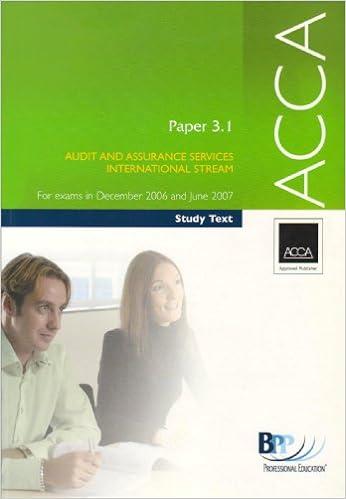Read the article "An Introduction to Evaluating Supplier Risk" and answer the questions below. 1. What is a "critical supplier"? 2. What are four (4) of the key criteria used to identify critical suppliers? 3. What is a critical supplier list and why is it important? 4. What are the three screens that can be used to successively reduce the number of suppliers to be monitored? 5. What does each of the three screens identify? 6. What is the benefit/risk of using an outside resource to help screen and monitor the supplier base? occur or reducing the probability they will occur, and (4) making contingency plans to mitigate the consequences if they do occur. "Though risk can emanate from many places at the selection stage we will focus on two major risks financial and operational. Financial risk management is defined as the continual monitoring of the strength of suppliers' financial condition to insure their ability to meet the purchaser's performance requirements for products or services. Most purchasers perform at least a cursory financial analysis of prospective suppliers. Although financial condition is not the sole criterion to evaluate a supplier, poor financial condition can indicate serious problems. A financial analysis performed during this phase of the process is much less comprehensive than the one performed during final supplier evaluation. During this phase, a purchaser is trying to get an indication of the overall financial health of the supplier. Buyers often consult external sources of information such as annual reports, 10K reports (available at www.sec.gov), and Dun \& Bradstreet (D\&B) reports to support the evaluation. Once a supplier is selected, several third-party providers can keep the buyer apprised of any problematic financial changes that would pose a disruption to supply. Operational risk manaqement focuses on the continued ability of the supplier's human, intellectual, and physical capital to meet the buying firm's requirements with respect to quality and delivery, In the long term, it involves meeting demand fluctuations, meeting new-product needs, and providing continually improved products and services. For example, one firm in the high-tech industry requires it suppliers to ramp-up volume for new-product introductions as well as meeting seasonal demands. The firm expects its suppliers to have the necessary operational capability and flexibility. In one example, the supply manager noticed that supplier delivery promises were being missed from a previously excellent mid-sized supplier. When the sourcing team visited the supplier facility they noticed a sizable drop in the number of employees from their previous visit a year ago. Discussions with the key managers revealed this supplier lost a major contract with a key customer. As a result, the firm offered early retirements to senior employees and then laid off many younger employees. The result was a sig. nificant "brain drain" and reduced capacity, leading to longer lead times and reduced flexibility in operations. Sourcing Snapshot An Introduction to Evaluating Supplier Risk Supplier risk can emanate from many points in the envirancent (e2., natural disasters) or within the supplier's organization. The intent of this snapshat is to provide a framework to develop and monitor supplier risk through first developing a critical supplier list and then monitoring sappliers on that list to identify potential risis prior to a critical evest that mould disrupt supply and create customer problems. Developing Critical Supplier List Of the thousands of seppliers a company has, only a relatively few fall into the critical category. A critical supplier is one whose fallure will greaty impact the bojing company. Deciding which suppliers fit this description will vary from firm to firm. However, some of the ley criteria used to identify critical seppliers include the following. - Strategic suppliers - Single suppliers - Sole suppliers - Suppliers with parts/servioes in many product lines or programs - Suppliers with a high-dollat value of company owned tooling - Seppliers with long qualification times - Sepplars with a high percentage of business with the company - Key disadvantaged suppliers Ultimately esch buying company determines which suppliers are ta be incledod on the critical supplier list. For example, one organizatise's rule was simply "we want all of our direct material suppliers with expenditures of over $10 mallion on the list." However, such a rule will usually resalt it too many suppliers on the critical list, se a second or third reend of evalustion will be needed to get the list to a manageable nember of truly critical suppliers. Whatever method is ased to create the critical supply list, the list will have to be periodically updated as the sepply base changos. Monitoring Suppliers Once the critical supplier list is developed there is a need to monitor these critical suppliers. Every company has a number of seppliers that, if they should fail, would significantly impact the besiness. A key step in supplier tisk management is identifying those relatively few soppliers who pose a high risk to the company. The challenge is to identify and monitor the high-risk suppliers. Identjfying hight-risk suppliers is best accomplished by a seties of screens that successively reduce the number of suppliers to be monitored. (See figure next.) The first screen identifies the critical seppl-ers, the second screen identifies critical suppliers with a high probability of financial or operational distress, and the last screen identifies the stressed seppliers that need intervention or mitigation. The decision to use an cutside resource to help screen and monitor the supplier base is one of the most important decisions the risk management team will make. Engaging a third-party provider of risk management services (3PR) will significanthy impact the risk management process and the overall cost of the program. Source Adopted trom "Suppliet Finencial and Opeitional Risk Managemert" by PL Carter \& LC. Curipera CAPS Riesearch Study 2011 Tempe, AZ 70 pages









